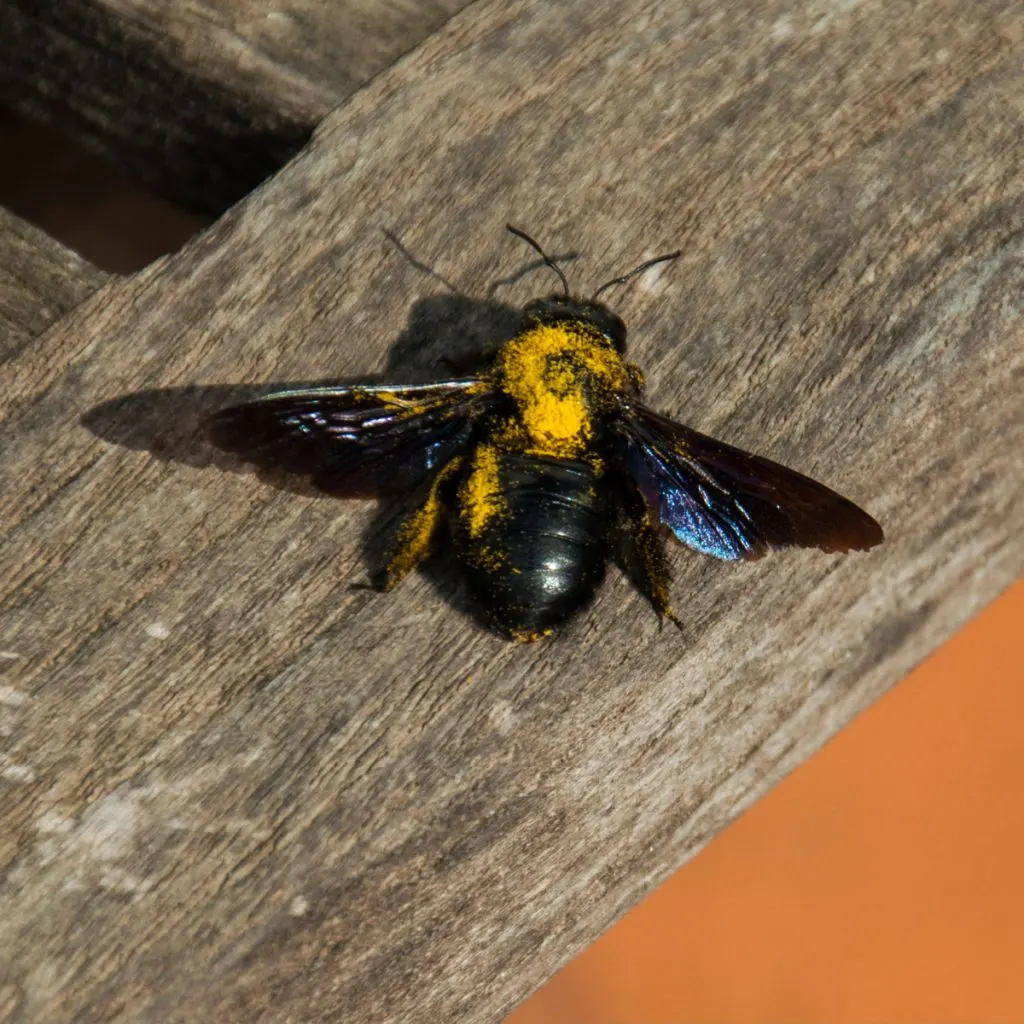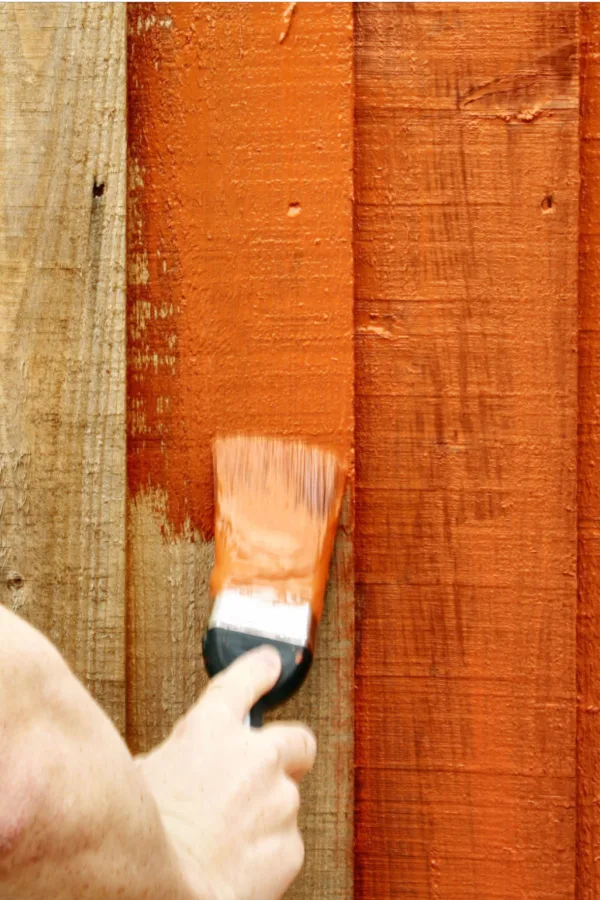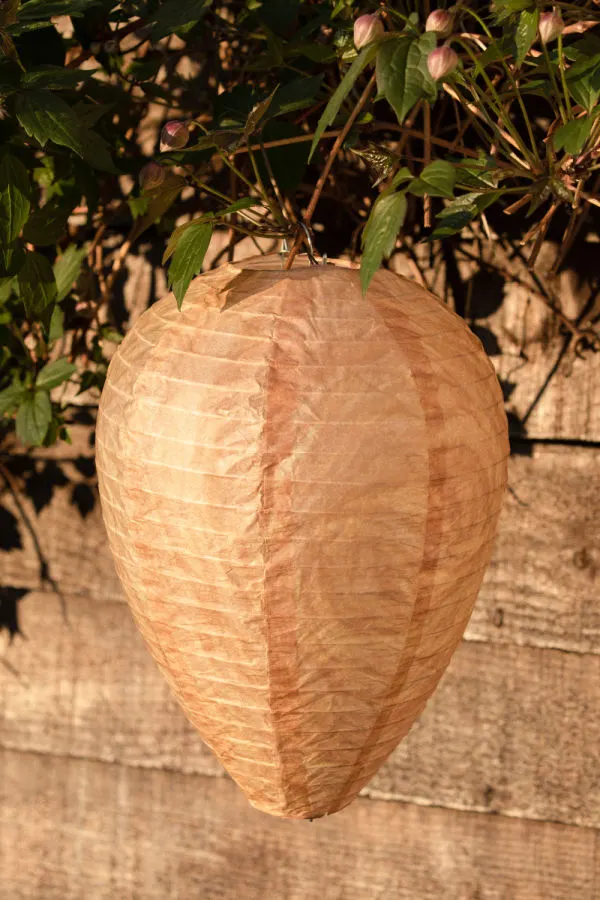Looking for a few simple tricks to stop carpenter bees from damaging and destroying the wood surfaces around your home, garage, shed, barn or fences?
Although spring may bring life to the great outdoors, it also brings carpenter bees. And can they ever destroy anything and everything made from wood. Carpenter bees love to drill holes into the wood on homes, barns, sheds, fences and more. And once they find a wood surface they like, they can quickly turn it into a Swiss-cheese look-a-like!
A carpenter bee resembles a bumblebee, but there are a few key differences that separate the two. For one, unlike bumble bees, carpenter bees do not have any hair on their stomach. Secondly, worker bumble bees and the queen bumble bee have stingers, while carpenter bees do not.

It is the third difference between the two, however, that creates a major issue for homeowners. Bumble bees live in nests and colonies in the ground. Carpenter bees on the other hand shelter by themselves – and unfortunately, those shelters are created in wood. And if you don’t put a stop to them “building” quickly, the damage can be severe.
3 Simple Tricks To Stop Carpenter Bees
Spotting The Damage
Contrary to what many think, carpenter bees are not dining on the wood. Instead, they drill out their near perfect holes to create a place for the female bee to lay larva and raise a new generation of carpenter bees.
If you spot sawdust underneath or around a wood surface, it is most likely the work of a carpenter bee. And if you look a little closer, you will most likely find a perfectly drilled hole near the sawdust. So perfect, that you would swear someone with a drill and a drill bit has been attacking your home!
Much as with honeybee hives, it is the female carpenter bees that do the majority of the work for the family. That work includes not only laying the larva and raising the young, but also drilling out the holes to create the nest.
So what purpose does the male serve for the family? Well if you have ever been around an active carpenter bee home, you have more likely encountered the male than the female.
The male’s sole purpose is to defend the nest and protect the female carpenter bee. And to do so, he spends nearly all his time hovering around the entrance to the hole. The good news is that he has no stinger and cannot harm you. He will, however, swoop in and fly straight at your head whenever you come close to the nest!
Why Insecticides Are Not The Answer
So why not just spray an insecticide against carpenter bees? As it turns out, especially for gardeners, killing them with an insecticide is not the best of answers. First and foremost, carpenter bees are actually a major pollinator. And not only are you killing off valuable pollinators, by spraying, you are also killing off any other helpful insects as well.
But the good news is you don’t have to resort to killing them to keep them from damaging the wood around your home. There are actually a few simple tricks that stop carpenter bees from destroying your home – but let’s them look elsewhere to build.
1. Staining & Painting Wood Surfaces To Stop Carpenter Bees
The number one rule when it comes to stopping carpenter bees with success is to never leave wood surfaces bare. Carpenter bees prefer untreated and unstained wood more than anything else. Because of that, a fresh coat of paint or stain is an excellent first line of defense.
For us, stain has always worked best. But a more glossy paint also has great repelling properties. If you do want to keep wood in its natural state, apply a high quality clear sealer to help seal the wood.
Before painting or staining, it is important to plug and seal any old carpenter bee holes. Carpenter bees have an excellent memory. In fact, they will return back to the same hole again and again. But by sealing off the holes, you eliminate an easy return.
Before plugging the hole with an exterior wood filler, be sure to clear it of any larvae that may be present. Not only can they still hatch, they can also be sought out by woodpeckers. And if woodpeckers start going after the wood around your home – you will unfortunately have a whole new level of wood damage!
2. Spraying Almond, Citrus Or Peppermint Oil To Stop Carpenter Bees
Like many insects, carpenter bees hate the smell of almond oil, citrus oil and peppermint oil. Because of this, all three are excellent to use as a natural repellent and protector for stopping carpenter bees.
Listen In To Our Podcast On Stopping Carpenter Bees Below!
Spraying any of the above mentioned oils into newly drilled holes will usually stop the bees from continuing their efforts. Wiping down high impact areas with the oil is also an excellent way to prevent them from drilling in the first place. This has been very effective for us in high prone carpenter bee areas like our wood eaves.
When using any oil, it is always important to test a small area first. This will help make sure it will not discolor or mar the surface you are trying to protect. In addition, you will need to reapply (especially if rain hits the area) often to keep its effectiveness. Affiliate Link : Baja Precious – Sweet Almond Oil, 1 Gallon
3. Using Fake Wasp Nests, Noise & Vibration
When it comes to repelling carpenter bees with a few old-fashioned tricks, there are a couple of tried and true methods that can be quite successful.
One of the best is installing a few “fake” paper wasp nests around areas where the bees are active. Wasps are a predator of carpenter bees, and love to eat their larvae. And when they see a wasp nest, they will simply fly away to a new area – and fast!
You can purchase fake wasp nests – or make a look-alike version by taking a balloon and putting it inside of a paper bag. Simply hang your fake wasp nests where you need protection to clear the area. Affiliate Product Link : Wasp Nest Decoy – 3 Pack- Eco Friendly Hanging Wasp Repellent
Noise and vibration is another method that can work to deter carpenter bees from drilling and nesting in a specific area. Not only can the noise scare them a bit, the vibrations also are thought to disrupt their ability to work and build their homes.
A great way to provide both noise and vibration is by installing wind chimes. The constant rattling and movement can have them looking for other places to call home. If you really want to protect an area, hang a few chimes and wasp nests for double the power!
One thing that does not work well in stopping carpenter bees are electronic pest repellent devices. The noise is simply not disruptive to the bees at all and will not keep them from coming in and building their nests.
Providing An Alternative…
Finally, another one of many tricks to stop carpenter bees and their damage – but still keep them around – is to give them their own place to call home!
Carpenter bees are an important pollinator for flowers and gardens. As they devour nectar from blooms, they also pollinate quite effectively in the process. With that in mind, you can also create a space for them to live in peace, and in the process, stop them from attacking your own wooden structures.
To do this, place a carpenter bee house near where they are active. These little houses (often called mason bee homes) have inviting pre-drilled spaces where bees can live. By hanging houses where hovering bees are present, you can attract them to the nest. Affiliate Link: Mason Bee House Wax Coated Mason Bee Hive Wooden Insect Hotel Carpenter Bee House
Once the bees head into the nest, you simply move it to the edge of your landscape. It is a bit more labor intensive, but it keeps them alive and away from your wood structures. Bees return to the same space year after year. Because of that, it’s a great way to peacefully and permanently relocate carpenter bees
Here is to finding a way to stop carpenter bees around your home – and the damage they cause! Happy Gardening – Jim & Mary.
Old World Garden Farms
Jim and Mary Competti have been writing gardening, DIY and recipe articles and books for over 15 years from their 46 acre Ohio farm. The two are frequent speakers on all things gardening and love to travel in their spare time.
As always, feel free to email us at thefarm@owgarden.com with comments, questions, or to simply say hello! You can sign up for our free email list in the subscribe now box in the middle of this article. Follow us on Facebook here : OWG Facebook. This article may contain affiliate links.



